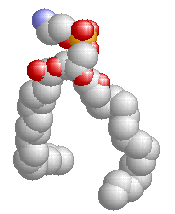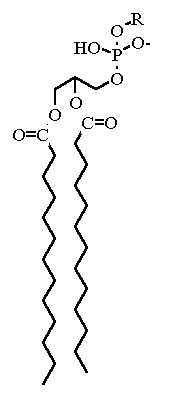
Elements of Protein Structure
Membrane Structure
The structure of cellular membranes are also driven by the hydrophobic effect. They are composed primarily of compunds called diacylglycerols. These molecules are all amphipathic, meaning that they are water soluble (polar) at one end and oil soluble (non-polar) on the other.
 |
 | Two representations of a diacylgycerol. The left is from a srtucture with the atoms represented as spheres and color by elememt. Notice how "gray" (Carbon) - nonpolar - the bottom is while the top has a lot of red (Oxygen), orange (Phosphorous) and blue (Nitrogen) - polar. The molecule on the right is the same one where you can clearly see the phophate and its charge at one end and the long nonpolar carbon "tails" at the other.
 Representation of a portion of membrane. The array proceeds in two dimensions: Left/right, and back into the screen. A planar array is made.
In general they contain two distinct regions: a polar end, represented in this picture by the end containing the "red oxygen" atoms and "orange phosphorous", and a non-polar tail, represented in this picture by the two gray tails. Molecules such as these self organize in water in a way that minimizes the contact of their hydrophobic tails with water. They tend to organize into two layers such that the hydrophobic parts are in contact with each other to exclude water while the polar parts are in contact with water. This sets up a situation in the center of the membrane that is mostly nonpolar in nature and can "dissolve" nonpolar molecules. Membranes play a very important role in biology. Beside keeping the cells together they also keep things out that should be "out" (toxins, bacteria etc.) and other things in that should be "in" (important proteins, metabolites, DNA). It is very difficult for charged molecules in particular to get through a membrane. This will be an extremely handy feature. Proteins embedded in the membrane play an exceedingly important role in "deciding" what compounds can pass through the membrane and when. We will see only a couple examples in this class, but there is a much larger set of functions that we will not have time to cover.
Representation of a portion of membrane. The array proceeds in two dimensions: Left/right, and back into the screen. A planar array is made.
In general they contain two distinct regions: a polar end, represented in this picture by the end containing the "red oxygen" atoms and "orange phosphorous", and a non-polar tail, represented in this picture by the two gray tails. Molecules such as these self organize in water in a way that minimizes the contact of their hydrophobic tails with water. They tend to organize into two layers such that the hydrophobic parts are in contact with each other to exclude water while the polar parts are in contact with water. This sets up a situation in the center of the membrane that is mostly nonpolar in nature and can "dissolve" nonpolar molecules. Membranes play a very important role in biology. Beside keeping the cells together they also keep things out that should be "out" (toxins, bacteria etc.) and other things in that should be "in" (important proteins, metabolites, DNA). It is very difficult for charged molecules in particular to get through a membrane. This will be an extremely handy feature. Proteins embedded in the membrane play an exceedingly important role in "deciding" what compounds can pass through the membrane and when. We will see only a couple examples in this class, but there is a much larger set of functions that we will not have time to cover.


 Representation of a portion of membrane. The array proceeds in two dimensions: Left/right, and back into the screen. A planar array is made.
In general they contain two distinct regions: a polar end, represented in this picture by the end containing the "red oxygen" atoms and "orange phosphorous", and a non-polar tail, represented in this picture by the two gray tails. Molecules such as these self organize in water in a way that minimizes the contact of their hydrophobic tails with water. They tend to organize into two layers such that the hydrophobic parts are in contact with each other to exclude water while the polar parts are in contact with water. This sets up a situation in the center of the membrane that is mostly nonpolar in nature and can "dissolve" nonpolar molecules. Membranes play a very important role in biology. Beside keeping the cells together they also keep things out that should be "out" (toxins, bacteria etc.) and other things in that should be "in" (important proteins, metabolites, DNA). It is very difficult for charged molecules in particular to get through a membrane. This will be an extremely handy feature. Proteins embedded in the membrane play an exceedingly important role in "deciding" what compounds can pass through the membrane and when. We will see only a couple examples in this class, but there is a much larger set of functions that we will not have time to cover.
Representation of a portion of membrane. The array proceeds in two dimensions: Left/right, and back into the screen. A planar array is made.
In general they contain two distinct regions: a polar end, represented in this picture by the end containing the "red oxygen" atoms and "orange phosphorous", and a non-polar tail, represented in this picture by the two gray tails. Molecules such as these self organize in water in a way that minimizes the contact of their hydrophobic tails with water. They tend to organize into two layers such that the hydrophobic parts are in contact with each other to exclude water while the polar parts are in contact with water. This sets up a situation in the center of the membrane that is mostly nonpolar in nature and can "dissolve" nonpolar molecules. Membranes play a very important role in biology. Beside keeping the cells together they also keep things out that should be "out" (toxins, bacteria etc.) and other things in that should be "in" (important proteins, metabolites, DNA). It is very difficult for charged molecules in particular to get through a membrane. This will be an extremely handy feature. Proteins embedded in the membrane play an exceedingly important role in "deciding" what compounds can pass through the membrane and when. We will see only a couple examples in this class, but there is a much larger set of functions that we will not have time to cover.
